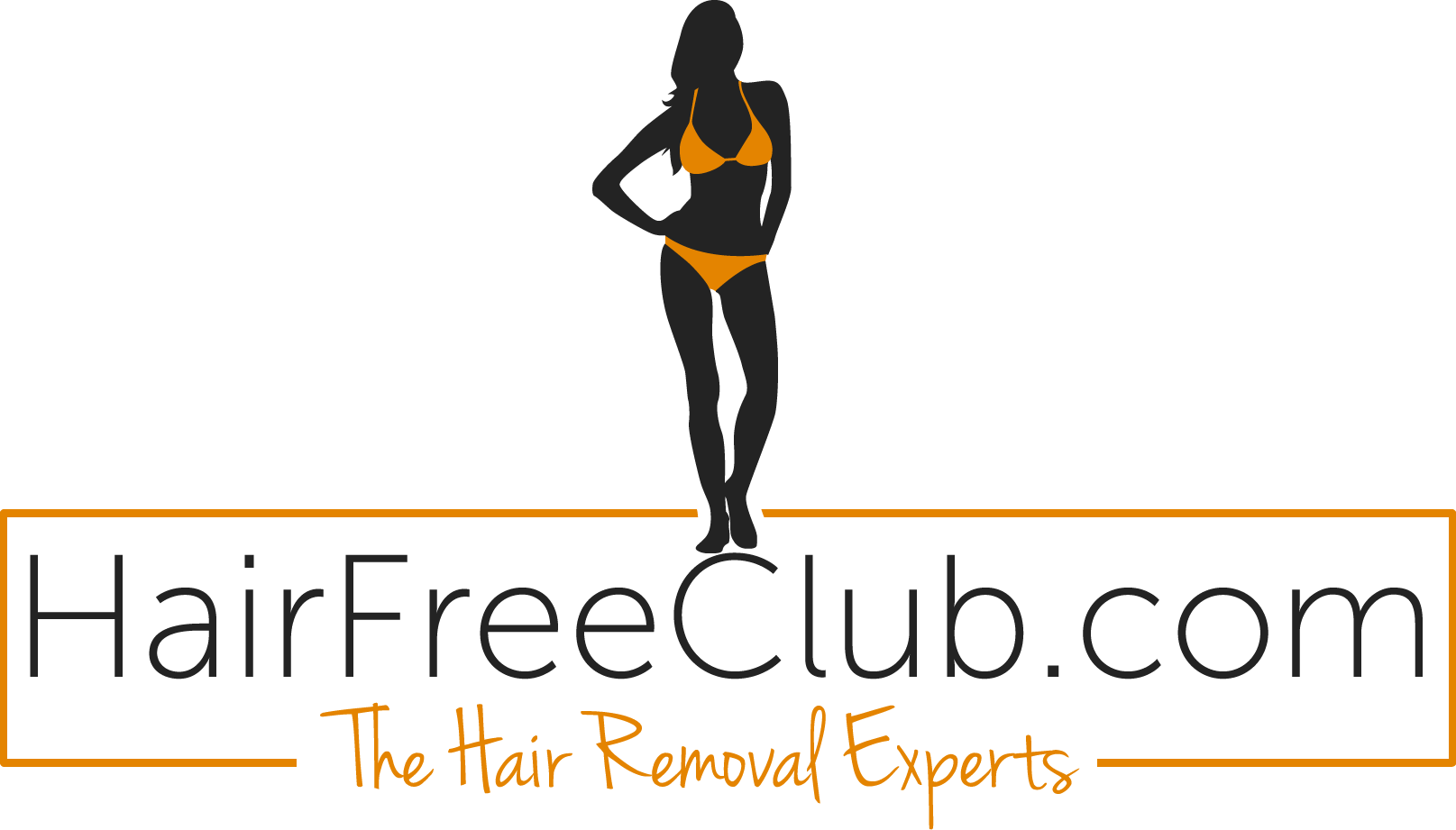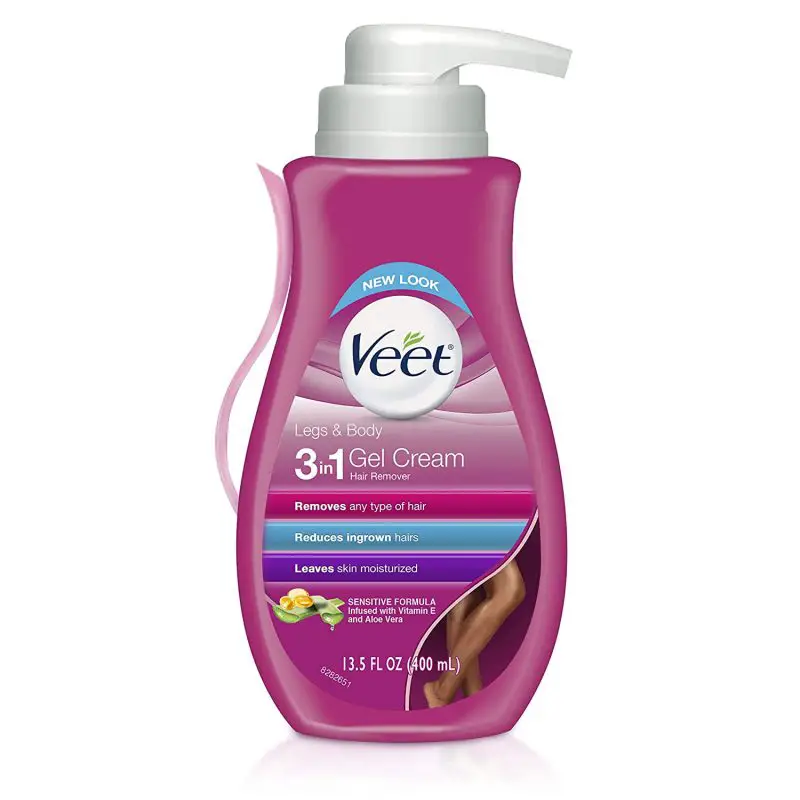3 in 1 Gel Cream Hair Remover by Veet
Veet 3 in 1 Gel Cream Hair Remover is a depilatory cream that is specifically formulated for sensitive skin. In addition to its depilatory agents, Veet 3 in 1 contains Aloe vera gel and alpha-tocopherol (vitamin E).
It is an extremely popular hair removal cream worldwide and is regarded as the number one seller globally. Thousands of people swear by this product.
Veet is the brand name of depilatory products made by Reckitt Benckiser company. First sold in 1919 as Neet (as in neat) and produced by Hannibal Pharmaceuticals, Neet was bought out by American Home Products in 1958, then transferred to the Canadian company Reckitt Benckiser.
Since the new formula owners were Canadian, the formula thereafter was renamed to Veet, (as in vite or quick in French, for products sold in Europe and the company retained the name Neet for the Canadian and US markets until 2002 (now, it’s all Veet).
Who’s It For?
Veet 3 in 1 Gel Cream is perfect for people who want to remove body hair without using a razor, but have very sensitive skin and do not do well with other depilatory products. If you are the type of person whose skin is sensitive to developing a razor burn from shaving, this is the product for you.
There are several advantages to using a chemical depilatory for hair removal rather than shaving.
Using a razor can produce what is termed as “chicken skin” appearance, resulting from scalped skin around the follicles which has become infected, thus developing into folliculitis.
Veet 3 in 1 will remove armpit and leg hair within 10 minutes (often within 5 minutes) of treatment. It a great choice for people with sensitive skin with its Aloe vera and vitamin E additions.
What We Like About 3 in 1 Gel Cream Hair Remover by Veet
Veet 3 in 1 works quickly and does not produce skin irritation in most people. Most users report complete issue-free hair removal after just 5 minutes of treatment.
Skin after treatment feels silky smooth and continues to feel this way for about two days afterward. This is due to the skin treatment additives, which are a nice touch that makes for an all-in-one (or 3 in 1) product.
What We Don’t Like About 3 in 1 Gel Cream Hair Remover by Veet
There is not a lot we could find that we did not like about Veet 3 in 1 Gel Cream. It works as advertised, is gentle on the skin, and does its job rather fast (usually in 5 minutes).
Many users complain about the rotten egg smell of the product, but that is simply what you get with thiols. Recall that the main active ingredient is potassium thioglycolate, potassium salt of thioglycolic acid.
We did find some reports of people who developed a mild rash along the bikini line or that the results produced patchy patterns of hair removal. For a homogeneous product to produce patchy results when users claim that they applied the product evenly suggests they had soap or detergent residues on their skin that neutralized the gel.
Bar soaps can run the range from a pH of 6 to 10, depending on the brand and formulation. Any soap residue left on the skin from a brand more in the neutral to the acid range (below pH 7.4, biological neutral) would result in squelching the chemical reaction in Veet gel.
Also, some users report that it does not remove underarm hair. If these users have a layer of deodorant in their axial area, the acidic deodorant/antiperspirant (pH 5.5-6.5) will neutralize the depilatory reaction, which runs at a pH of 12. That will result in no depilatory reaction, which may be the reason for these reports.
PROS
- Quick and efficient hair removal
- Leaves skin feeling silky for days
- Only small amounts of hair regrowth after a week
CONS
- Prolonged exposure during treatment can produce a mild chemical burn
- Skin retains a pungent burning smell for some time after washing
What’s Included?
Veet 3 in 1 comes in a package with a 400 ml (13.5 oz) bottle with a pump dispenser and a plastic spatula with a rubber lip. The bottle is a hot pink with a white pump dispenser and the spatula basically matches (white spatula with a hot pink rubber lip).
Instructions are provided on the reverse side of the Veet bottle and are very straightforward. All of it simple, iconographic, and pictorial with a little text.
On the bottle, it states that Veet acts as a depilatory for any type of hair and that the method of removal reduces problems with ingrown hair experienced with shaving. It highlights the vitamin E and Aloe vera additions to the cream.
Overview Of Features
Since Veet is applied to your skin and skin is sensitive and can absorb things both good and bad, we will review the functions of the various product ingredients. Many people are concerned about additives in skin products (and other products, in general) and mostly have no idea what each thing does.
With all the confusing names, it’s easy to feel in the dark about what is going on your skin and whether it is considered safe today, but not tomorrow. Below, we will list out all the ingredients, which are safe and FDA-approved, and what each of them does for you.
Those ingredients are (in order of concentration): Water, urea, mineral oil, cetearyl alcohol, potassium thioglycolate, calcium hydroxide, talc, ceteareth-20, glycerin, sorbitol, fragrance, magnesium trisilicate, propylene glycol, lithium magnesium sodium silicate, sodium gluconate, tocopheryl acetate, Aloe barbadensis leaf juice, acrylates copolymer, potassium sorbate, sodium benzoate, titanium dioxide.
Urea works in concert with potassium thioglycolate to maintain the chemical changes in the hair shaft keratin after the breaking reaction. The active depilatory ingredient, potassium thioglycolate, liberates thioglycolic acid in reaction, which attacks cystines (“sulfur bridges”) in the keratin polymer.
Cystines (cysteine-cysteine dimers) are chemical crosslinks in protein that help to stabilize its three-dimensional structure and breaking them causes instability and protein-polymer shearing. This is a process called denaturation, which is the same process that occurs when you cook an egg white and it turns white.
The egg white protein (mostly albumin) begins to break down from the cooking heat first by a loss of sulfur bridges, thus unraveling the protein structure and changing its refractive index from appearing clear to white and opaque. In like fashion, the thioglycolic acid breaks those bridges and denatures the keratin protein polymer.
The products of the reaction are dithiodiglycolic acid and reduced cysteines in the keratin polymer. Occasionally, these reduced cysteines can re-react and form new sulfur-sulfur bridges, therefore undoing the chemical reaction.
Urea ensures this does not occur by forming bonds with the free cysteines, thus ensuring that the protein remains completely structurally destabilized. Protein destabilization will then ensure polymer shearing and breakage of the hair shaft.
Mineral oil is a petroleum product that is commonly used in cosmetics to produce a smooth, flowable substance for easy application. The grade of mineral oil is a fine, noncomedogenic grade.
Cetearyl alcohol and ceteareth-20 are a mix of C-16 (cetyl) and C-18 (stearyl) alcohols, referred to commercially as fatty alcohols due to their long carbon chains and similarity to fatty acids. They are mainly used as emulsifiers, emollients, and skin penetration enhancers.
Calcium hydroxide and magnesium trisilicate are part of the pH buffering system that maintains a product pH of 12. Sodium gluconate is a chelating agent (binds metals) that assists the buffer system.
Talc is a clay-based mineral that is mostly magnesium silicate hydroxide. It is primarily used as a lubricant and thickening agent. Additional thickening agents in the product are acrylates copolymer, an acrylamide gel, and sorbitol (see below).
Thickeners, emollients, and humectants: Glycerin, or glycerol, is included as an emollient for moisturizing skin and as a humectant to keep the product moist. Sorbitol is a sugar alcohol made from reduced glucose and used as a thickener and humectant.
Propylene glycol is a short carbon chain alcohol used as a hygroscopic and humectant and carrier base.
Lithium magnesium sodium silicate is a temporary skin tightener that produces a thin coating on the skin.
Tocopheryl acetate is a derivative of vitamin E (alpha-tocopherol) and acts as an antioxidant to protect the skin in general and during the depilatory chemical reaction.
Aloe barbadensis leaf juice is an Aloe vera gel (Aloe barbadensis is a botanical synonym term that is no longer used, except in the cosmetics industry).
Potassium sorbate and sodium benzoates are preservative agents to prevent fungal and bacterial growth in the product. Titanium dioxide has anti-oxidant properties and also acts as a whitening pigment.
How to use
- Spread the cream in an even layer with the spatula.
- Leave for 5-10 minutes (10 minutes if you have thick hair): 10 minutes is the max
- Use the spatula to gently scrape off the cream.
- Rinse your skin thoroughly with water (no soap) and pat to dry.
You May Also Like: A Deep Dive into the mē Chic by mē my elōs
Review Summary
Veet 3 in 1 Gel Cream is a great choice for people who want a chemical depilatory but have very sensitive skin. The main ingredients, thioglycolate, vitamin E, and Aloe vera are an effective combination of skin treatment that does not require additional moisturizers after use.
The pump action bottle is also a nice touch for convenience and for dispensing a measured amount of gel. This is an ideal depilatory to achieve smooth skin.
See Related Article: Sleek Depilatory by elōs-mē Review


